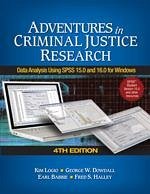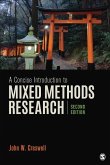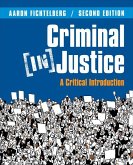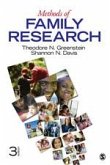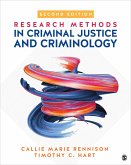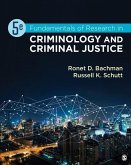Kim A Logio, George W Dowdall, Earl R Babbie, Frederick S Halley
Adventures in Criminal Justice Research
Data Analysis Using SPSS 15.0 and 16.0 for Windows
Kim A Logio, George W Dowdall, Earl R Babbie, Frederick S Halley
Adventures in Criminal Justice Research
Data Analysis Using SPSS 15.0 and 16.0 for Windows
- Broschiertes Buch
- Merkliste
- Auf die Merkliste
- Bewerten Bewerten
- Teilen
- Produkt teilen
- Produkterinnerung
- Produkterinnerung
This text is an ideal supplement to any research methods in criminal justice textbook. Used primarily in lab settings, this text teaches students how to analyze issues and use SPSS for criminal justice research. The text explains to students, with the aid of step-by-step instructions in over 150 Windows screen shots, how to conduct and analyze their own surveys, comparing data collected with national data. Recent GSS data sets, including 2000 Census data, and the Public Health College Alcohol Survey, are utilized and available on a bundled CD.
Andere Kunden interessierten sich auch für
![A Concise Introduction to Mixed Methods Research A Concise Introduction to Mixed Methods Research]() John W CreswellA Concise Introduction to Mixed Methods Research49,99 €
John W CreswellA Concise Introduction to Mixed Methods Research49,99 €![Criminal (In)Justice Criminal (In)Justice]() Aaron FichtelbergCriminal (In)Justice147,99 €
Aaron FichtelbergCriminal (In)Justice147,99 €![A Practical Introduction to Real-World Research A Practical Introduction to Real-World Research]() Loreen WolferA Practical Introduction to Real-World Research190,99 €
Loreen WolferA Practical Introduction to Real-World Research190,99 €![Methods of Family Research Methods of Family Research]() Theodore N GreensteinMethods of Family Research166,99 €
Theodore N GreensteinMethods of Family Research166,99 €![Research Methods in Criminal Justice and Criminology Research Methods in Criminal Justice and Criminology]() Callie Marie RennisonResearch Methods in Criminal Justice and Criminology230,99 €
Callie Marie RennisonResearch Methods in Criminal Justice and Criminology230,99 €![Researching Criminology Researching Criminology]() Iain CrowResearching Criminology39,99 €
Iain CrowResearching Criminology39,99 €![Fundamentals of Research in Criminology and Criminal Justice Fundamentals of Research in Criminology and Criminal Justice]() Ronet D BachmanFundamentals of Research in Criminology and Criminal Justice190,99 €
Ronet D BachmanFundamentals of Research in Criminology and Criminal Justice190,99 €-
-
-
This text is an ideal supplement to any research methods in criminal justice textbook. Used primarily in lab settings, this text teaches students how to analyze issues and use SPSS for criminal justice research. The text explains to students, with the aid of step-by-step instructions in over 150 Windows screen shots, how to conduct and analyze their own surveys, comparing data collected with national data. Recent GSS data sets, including 2000 Census data, and the Public Health College Alcohol Survey, are utilized and available on a bundled CD.
Hinweis: Dieser Artikel kann nur an eine deutsche Lieferadresse ausgeliefert werden.
Hinweis: Dieser Artikel kann nur an eine deutsche Lieferadresse ausgeliefert werden.
Produktdetails
- Produktdetails
- Verlag: Sage Publications
- 4th edition
- Seitenzahl: 216
- Erscheinungstermin: 22. Februar 2008
- Englisch
- Abmessung: 278mm x 216mm x 12mm
- Gewicht: 517g
- ISBN-13: 9781412963510
- ISBN-10: 1412963516
- Artikelnr.: 23486481
- Verlag: Sage Publications
- 4th edition
- Seitenzahl: 216
- Erscheinungstermin: 22. Februar 2008
- Englisch
- Abmessung: 278mm x 216mm x 12mm
- Gewicht: 517g
- ISBN-13: 9781412963510
- ISBN-10: 1412963516
- Artikelnr.: 23486481
Kim A. Logio is an Assistant Professor of Sociology at Saint Joseph¿s University in Philadelphia. She teaches research methods for sociology and criminal justice students. She is actively involved in research on victims of juvenile crime and adolescent body image.
About the Authors
Preface for Instructors
Part I: Preparing for Criminal Justice Research
Chapter 1: Theory, Measurement, and Research Development
1.1 Research in Criminal Justice
1.2 Theory in Criminal Justice: Routine Activity Theory
1.3 Hypotheses in Criminal Justice Research
1.4 Should Abortion Be Legal?
1.5 Crime, Punishment, and Violence
1.6 The Logic of Measurement
1.7 Validity Problems
1.8 Reliability Problems
1.9 Multiple Indicators
1.10 Level of Measurement
1.11 Units of Analysis
1.12 Summary
Chapter 2: Criminal Justice Data Sets
2.1 Primary and Secondary Data Analysis
2.2 Description of a Data Set: The General Social Survey
2.3 Sampling: How Representative Are Your Data?
2.4 Data Collection
2.5 General Social Survey Variables
2.6 Harvard School of Public Health College Alcohol Study
2.7 Other Criminal Justice Data Sets Available on the Web
2.8 Downloading Data from the Internet
2.9 Your Own Criminal Justice Survey
2.10 Summary
Chapter 3: Using SPSS
3.1 Using SPSS to Open Existing Data Sets
3.2 Learning More: The Windows Tutorial
3.3 Creating Your Own Data Set
3.4 Coding Your Data
3.5 Entering Your Data
3.6 Using Published Criminal Justice Data
3.7 Summary
Part II: Univariate Analysis
Chapter 4: Describing a Variable
4.1 A Graphic View
4.2 Measuring Central Tendency and Dispersion
4.3 Modifying Variables With Recode
4.4 Practicing Recodes
4.5 Saving Your Work
4.6 Summary
Chapter 5: Working With Variables
5.1 Political Views: Liberalism Versus Conservatism
5.2 Political Policy Affiliation
5.3 Gun Laws and Capital Punishment
5.4 Understanding Binge Drinking
5.5 Other Survey Items About Crime and Justice
5.6 Crime and Justice Data for the American States
5.7 Summary
Chapter 6: Creating Composite Measures
6.1 Using Crosstabs
6.2 Combining Two Items in an Index
6.3 Checking to See How the Index Works
6.4 Creating a More Complex Index With Count
6.5 Creating the FBI Crime Index
6.6 "Secondhand Binge Effects": Creating an Index
6.7 Summary
Part III: Bivariate Analysis
Chapter 7: Investigating the Correlates of Binge Drinking and Attitudes
Toward Gun Control and Capital Punishment: Independent Versus Dependent
Variables
7.1 Moving Beyond Description: Comparing Two Variables
7.2 Comparing Binge Drinking and Gender
7.3 Examining Binge Drinking and Race
7.4 Continuing the Analysis: Binge Drinking and Religiosity
7.5 The Impact of the Minimum Purchase Law: Bingeing and Age
7.6 Political Orientation, Guns, and Capital Punishment: Independent Versus
Dependent Variables
7.7 The Relationship Between POLVIEWS and PARTYID
7.8 Age and Politics
7.9 Religion and Politics
7.10 Gender and Politics
7.11 Race, Class, and Politics
7.12 Education and Politics
7.13 Martial Status and Politics
7.14 Gun Laws and Capital Punishment
7.15 Summary
Chapter 8: Measures of Association
8.1 Lambda
8.2 Gamma
8.3 Pearson¿s r, the Correlation Coefficient
8.4 Regression
8.5 Summary
Chapter 9: The Existence, Strength, and Direction of an Association
9.1 Chi-Square
9.2 t-Tests
9.3 Analysis of Variance
9.4 Summary
Part IV: Multivariate Analysis
Chapter 10: Examining Several Independent Variables
10.1 Age, Sex, and Religiosity
10.2 Family Status and Religiosity
10.3 Social Class and Religiosity
10.4 Other Variables to Explore
10.5 Multiple Linear Regression
10.6 Summary
Chapter 11: Exploring What Shapes Attitudes About Guns and Capital
Punishment
11.1 Political Philosophy and Party Identification
11.2 The Mystery of Politics and Marital Status
11.3 Guns and Capital Punishment
11.4 Summary
Chapter 12: Logistic Regression: Understanding College Student Drug and
Alcohol Abuse
12.1 Binge Drinking: A Dichotomous Dependent Variable
12.2 The Odds Ratio: Gender and Binge Drinking
12.3 Using SPSS for Windows Student Version for the Odds Ratio
12.4 Logistic Regression in SPSS for Windows
12.5 Multiple Logistic Regression
12.6 Summary
Appendix A: How to Read a Research Article
Appendix B: College Alcohol Study Questionnaire (on the Student Study Site)
Appendix C: Chapter Review Quizzes and Independent Projects (on the Student
Study Site)
Appendix D: Answers to Chapter Review Quizzes (on the Student Study Site)
References and Suggested Readings
Glossary/Index
Preface for Instructors
Part I: Preparing for Criminal Justice Research
Chapter 1: Theory, Measurement, and Research Development
1.1 Research in Criminal Justice
1.2 Theory in Criminal Justice: Routine Activity Theory
1.3 Hypotheses in Criminal Justice Research
1.4 Should Abortion Be Legal?
1.5 Crime, Punishment, and Violence
1.6 The Logic of Measurement
1.7 Validity Problems
1.8 Reliability Problems
1.9 Multiple Indicators
1.10 Level of Measurement
1.11 Units of Analysis
1.12 Summary
Chapter 2: Criminal Justice Data Sets
2.1 Primary and Secondary Data Analysis
2.2 Description of a Data Set: The General Social Survey
2.3 Sampling: How Representative Are Your Data?
2.4 Data Collection
2.5 General Social Survey Variables
2.6 Harvard School of Public Health College Alcohol Study
2.7 Other Criminal Justice Data Sets Available on the Web
2.8 Downloading Data from the Internet
2.9 Your Own Criminal Justice Survey
2.10 Summary
Chapter 3: Using SPSS
3.1 Using SPSS to Open Existing Data Sets
3.2 Learning More: The Windows Tutorial
3.3 Creating Your Own Data Set
3.4 Coding Your Data
3.5 Entering Your Data
3.6 Using Published Criminal Justice Data
3.7 Summary
Part II: Univariate Analysis
Chapter 4: Describing a Variable
4.1 A Graphic View
4.2 Measuring Central Tendency and Dispersion
4.3 Modifying Variables With Recode
4.4 Practicing Recodes
4.5 Saving Your Work
4.6 Summary
Chapter 5: Working With Variables
5.1 Political Views: Liberalism Versus Conservatism
5.2 Political Policy Affiliation
5.3 Gun Laws and Capital Punishment
5.4 Understanding Binge Drinking
5.5 Other Survey Items About Crime and Justice
5.6 Crime and Justice Data for the American States
5.7 Summary
Chapter 6: Creating Composite Measures
6.1 Using Crosstabs
6.2 Combining Two Items in an Index
6.3 Checking to See How the Index Works
6.4 Creating a More Complex Index With Count
6.5 Creating the FBI Crime Index
6.6 "Secondhand Binge Effects": Creating an Index
6.7 Summary
Part III: Bivariate Analysis
Chapter 7: Investigating the Correlates of Binge Drinking and Attitudes
Toward Gun Control and Capital Punishment: Independent Versus Dependent
Variables
7.1 Moving Beyond Description: Comparing Two Variables
7.2 Comparing Binge Drinking and Gender
7.3 Examining Binge Drinking and Race
7.4 Continuing the Analysis: Binge Drinking and Religiosity
7.5 The Impact of the Minimum Purchase Law: Bingeing and Age
7.6 Political Orientation, Guns, and Capital Punishment: Independent Versus
Dependent Variables
7.7 The Relationship Between POLVIEWS and PARTYID
7.8 Age and Politics
7.9 Religion and Politics
7.10 Gender and Politics
7.11 Race, Class, and Politics
7.12 Education and Politics
7.13 Martial Status and Politics
7.14 Gun Laws and Capital Punishment
7.15 Summary
Chapter 8: Measures of Association
8.1 Lambda
8.2 Gamma
8.3 Pearson¿s r, the Correlation Coefficient
8.4 Regression
8.5 Summary
Chapter 9: The Existence, Strength, and Direction of an Association
9.1 Chi-Square
9.2 t-Tests
9.3 Analysis of Variance
9.4 Summary
Part IV: Multivariate Analysis
Chapter 10: Examining Several Independent Variables
10.1 Age, Sex, and Religiosity
10.2 Family Status and Religiosity
10.3 Social Class and Religiosity
10.4 Other Variables to Explore
10.5 Multiple Linear Regression
10.6 Summary
Chapter 11: Exploring What Shapes Attitudes About Guns and Capital
Punishment
11.1 Political Philosophy and Party Identification
11.2 The Mystery of Politics and Marital Status
11.3 Guns and Capital Punishment
11.4 Summary
Chapter 12: Logistic Regression: Understanding College Student Drug and
Alcohol Abuse
12.1 Binge Drinking: A Dichotomous Dependent Variable
12.2 The Odds Ratio: Gender and Binge Drinking
12.3 Using SPSS for Windows Student Version for the Odds Ratio
12.4 Logistic Regression in SPSS for Windows
12.5 Multiple Logistic Regression
12.6 Summary
Appendix A: How to Read a Research Article
Appendix B: College Alcohol Study Questionnaire (on the Student Study Site)
Appendix C: Chapter Review Quizzes and Independent Projects (on the Student
Study Site)
Appendix D: Answers to Chapter Review Quizzes (on the Student Study Site)
References and Suggested Readings
Glossary/Index
About the Authors
Preface for Instructors
Part I: Preparing for Criminal Justice Research
Chapter 1: Theory, Measurement, and Research Development
1.1 Research in Criminal Justice
1.2 Theory in Criminal Justice: Routine Activity Theory
1.3 Hypotheses in Criminal Justice Research
1.4 Should Abortion Be Legal?
1.5 Crime, Punishment, and Violence
1.6 The Logic of Measurement
1.7 Validity Problems
1.8 Reliability Problems
1.9 Multiple Indicators
1.10 Level of Measurement
1.11 Units of Analysis
1.12 Summary
Chapter 2: Criminal Justice Data Sets
2.1 Primary and Secondary Data Analysis
2.2 Description of a Data Set: The General Social Survey
2.3 Sampling: How Representative Are Your Data?
2.4 Data Collection
2.5 General Social Survey Variables
2.6 Harvard School of Public Health College Alcohol Study
2.7 Other Criminal Justice Data Sets Available on the Web
2.8 Downloading Data from the Internet
2.9 Your Own Criminal Justice Survey
2.10 Summary
Chapter 3: Using SPSS
3.1 Using SPSS to Open Existing Data Sets
3.2 Learning More: The Windows Tutorial
3.3 Creating Your Own Data Set
3.4 Coding Your Data
3.5 Entering Your Data
3.6 Using Published Criminal Justice Data
3.7 Summary
Part II: Univariate Analysis
Chapter 4: Describing a Variable
4.1 A Graphic View
4.2 Measuring Central Tendency and Dispersion
4.3 Modifying Variables With Recode
4.4 Practicing Recodes
4.5 Saving Your Work
4.6 Summary
Chapter 5: Working With Variables
5.1 Political Views: Liberalism Versus Conservatism
5.2 Political Policy Affiliation
5.3 Gun Laws and Capital Punishment
5.4 Understanding Binge Drinking
5.5 Other Survey Items About Crime and Justice
5.6 Crime and Justice Data for the American States
5.7 Summary
Chapter 6: Creating Composite Measures
6.1 Using Crosstabs
6.2 Combining Two Items in an Index
6.3 Checking to See How the Index Works
6.4 Creating a More Complex Index With Count
6.5 Creating the FBI Crime Index
6.6 "Secondhand Binge Effects": Creating an Index
6.7 Summary
Part III: Bivariate Analysis
Chapter 7: Investigating the Correlates of Binge Drinking and Attitudes
Toward Gun Control and Capital Punishment: Independent Versus Dependent
Variables
7.1 Moving Beyond Description: Comparing Two Variables
7.2 Comparing Binge Drinking and Gender
7.3 Examining Binge Drinking and Race
7.4 Continuing the Analysis: Binge Drinking and Religiosity
7.5 The Impact of the Minimum Purchase Law: Bingeing and Age
7.6 Political Orientation, Guns, and Capital Punishment: Independent Versus
Dependent Variables
7.7 The Relationship Between POLVIEWS and PARTYID
7.8 Age and Politics
7.9 Religion and Politics
7.10 Gender and Politics
7.11 Race, Class, and Politics
7.12 Education and Politics
7.13 Martial Status and Politics
7.14 Gun Laws and Capital Punishment
7.15 Summary
Chapter 8: Measures of Association
8.1 Lambda
8.2 Gamma
8.3 Pearson¿s r, the Correlation Coefficient
8.4 Regression
8.5 Summary
Chapter 9: The Existence, Strength, and Direction of an Association
9.1 Chi-Square
9.2 t-Tests
9.3 Analysis of Variance
9.4 Summary
Part IV: Multivariate Analysis
Chapter 10: Examining Several Independent Variables
10.1 Age, Sex, and Religiosity
10.2 Family Status and Religiosity
10.3 Social Class and Religiosity
10.4 Other Variables to Explore
10.5 Multiple Linear Regression
10.6 Summary
Chapter 11: Exploring What Shapes Attitudes About Guns and Capital
Punishment
11.1 Political Philosophy and Party Identification
11.2 The Mystery of Politics and Marital Status
11.3 Guns and Capital Punishment
11.4 Summary
Chapter 12: Logistic Regression: Understanding College Student Drug and
Alcohol Abuse
12.1 Binge Drinking: A Dichotomous Dependent Variable
12.2 The Odds Ratio: Gender and Binge Drinking
12.3 Using SPSS for Windows Student Version for the Odds Ratio
12.4 Logistic Regression in SPSS for Windows
12.5 Multiple Logistic Regression
12.6 Summary
Appendix A: How to Read a Research Article
Appendix B: College Alcohol Study Questionnaire (on the Student Study Site)
Appendix C: Chapter Review Quizzes and Independent Projects (on the Student
Study Site)
Appendix D: Answers to Chapter Review Quizzes (on the Student Study Site)
References and Suggested Readings
Glossary/Index
Preface for Instructors
Part I: Preparing for Criminal Justice Research
Chapter 1: Theory, Measurement, and Research Development
1.1 Research in Criminal Justice
1.2 Theory in Criminal Justice: Routine Activity Theory
1.3 Hypotheses in Criminal Justice Research
1.4 Should Abortion Be Legal?
1.5 Crime, Punishment, and Violence
1.6 The Logic of Measurement
1.7 Validity Problems
1.8 Reliability Problems
1.9 Multiple Indicators
1.10 Level of Measurement
1.11 Units of Analysis
1.12 Summary
Chapter 2: Criminal Justice Data Sets
2.1 Primary and Secondary Data Analysis
2.2 Description of a Data Set: The General Social Survey
2.3 Sampling: How Representative Are Your Data?
2.4 Data Collection
2.5 General Social Survey Variables
2.6 Harvard School of Public Health College Alcohol Study
2.7 Other Criminal Justice Data Sets Available on the Web
2.8 Downloading Data from the Internet
2.9 Your Own Criminal Justice Survey
2.10 Summary
Chapter 3: Using SPSS
3.1 Using SPSS to Open Existing Data Sets
3.2 Learning More: The Windows Tutorial
3.3 Creating Your Own Data Set
3.4 Coding Your Data
3.5 Entering Your Data
3.6 Using Published Criminal Justice Data
3.7 Summary
Part II: Univariate Analysis
Chapter 4: Describing a Variable
4.1 A Graphic View
4.2 Measuring Central Tendency and Dispersion
4.3 Modifying Variables With Recode
4.4 Practicing Recodes
4.5 Saving Your Work
4.6 Summary
Chapter 5: Working With Variables
5.1 Political Views: Liberalism Versus Conservatism
5.2 Political Policy Affiliation
5.3 Gun Laws and Capital Punishment
5.4 Understanding Binge Drinking
5.5 Other Survey Items About Crime and Justice
5.6 Crime and Justice Data for the American States
5.7 Summary
Chapter 6: Creating Composite Measures
6.1 Using Crosstabs
6.2 Combining Two Items in an Index
6.3 Checking to See How the Index Works
6.4 Creating a More Complex Index With Count
6.5 Creating the FBI Crime Index
6.6 "Secondhand Binge Effects": Creating an Index
6.7 Summary
Part III: Bivariate Analysis
Chapter 7: Investigating the Correlates of Binge Drinking and Attitudes
Toward Gun Control and Capital Punishment: Independent Versus Dependent
Variables
7.1 Moving Beyond Description: Comparing Two Variables
7.2 Comparing Binge Drinking and Gender
7.3 Examining Binge Drinking and Race
7.4 Continuing the Analysis: Binge Drinking and Religiosity
7.5 The Impact of the Minimum Purchase Law: Bingeing and Age
7.6 Political Orientation, Guns, and Capital Punishment: Independent Versus
Dependent Variables
7.7 The Relationship Between POLVIEWS and PARTYID
7.8 Age and Politics
7.9 Religion and Politics
7.10 Gender and Politics
7.11 Race, Class, and Politics
7.12 Education and Politics
7.13 Martial Status and Politics
7.14 Gun Laws and Capital Punishment
7.15 Summary
Chapter 8: Measures of Association
8.1 Lambda
8.2 Gamma
8.3 Pearson¿s r, the Correlation Coefficient
8.4 Regression
8.5 Summary
Chapter 9: The Existence, Strength, and Direction of an Association
9.1 Chi-Square
9.2 t-Tests
9.3 Analysis of Variance
9.4 Summary
Part IV: Multivariate Analysis
Chapter 10: Examining Several Independent Variables
10.1 Age, Sex, and Religiosity
10.2 Family Status and Religiosity
10.3 Social Class and Religiosity
10.4 Other Variables to Explore
10.5 Multiple Linear Regression
10.6 Summary
Chapter 11: Exploring What Shapes Attitudes About Guns and Capital
Punishment
11.1 Political Philosophy and Party Identification
11.2 The Mystery of Politics and Marital Status
11.3 Guns and Capital Punishment
11.4 Summary
Chapter 12: Logistic Regression: Understanding College Student Drug and
Alcohol Abuse
12.1 Binge Drinking: A Dichotomous Dependent Variable
12.2 The Odds Ratio: Gender and Binge Drinking
12.3 Using SPSS for Windows Student Version for the Odds Ratio
12.4 Logistic Regression in SPSS for Windows
12.5 Multiple Logistic Regression
12.6 Summary
Appendix A: How to Read a Research Article
Appendix B: College Alcohol Study Questionnaire (on the Student Study Site)
Appendix C: Chapter Review Quizzes and Independent Projects (on the Student
Study Site)
Appendix D: Answers to Chapter Review Quizzes (on the Student Study Site)
References and Suggested Readings
Glossary/Index
